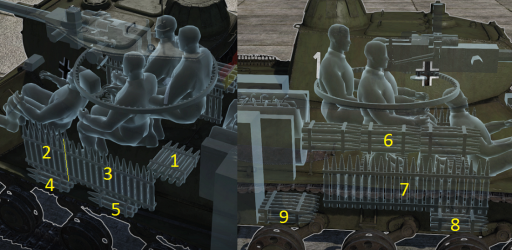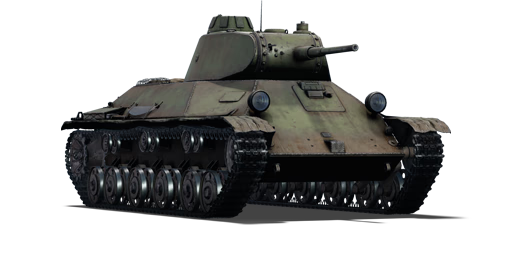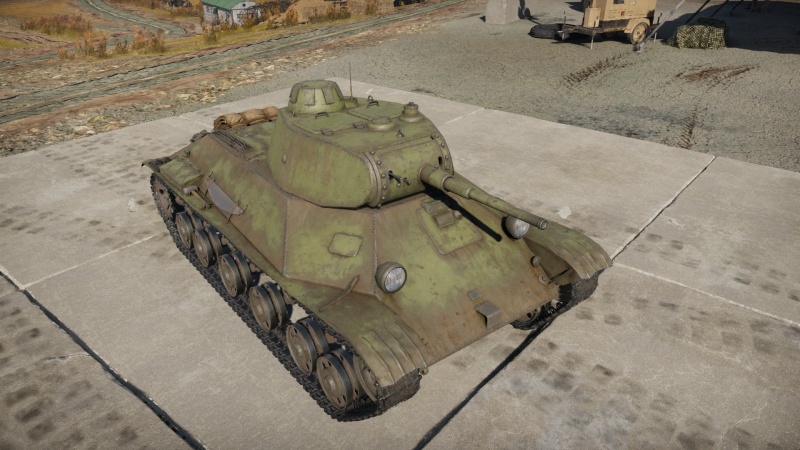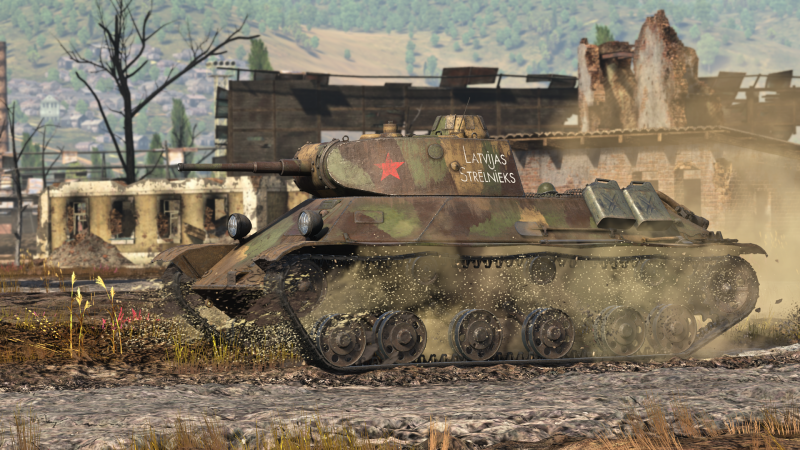Difference between revisions of "T-50"
(→Media: Removed dead video) |
m (Added Specs-Card ArtImage) |
||
| Line 1: | Line 1: | ||
{{Specs-Card | {{Specs-Card | ||
|code=ussr_t_50 | |code=ussr_t_50 | ||
| − | |images={{Specs-Card-Image|GarageImage_{{PAGENAME}}.jpg}} | + | |images={{Specs-Card-Image|GarageImage_{{PAGENAME}}.jpg|ArtImage_{{PAGENAME}}.png}} |
}} | }} | ||
Revision as of 00:18, 16 January 2023
Contents
Description
The T-50 is a rank Soviet light tank with a battle rating of (AB), (RB), and (SB). It was introduced during the Closed Beta Test for Ground Forces before Update 1.41. It is an effective light tank with great sloping armour and an adequate 45 mm cannon, a great vehicle for beginners getting used to the Soviet playstyle in higher ranks. Basically, the T-50 is a mini T-34 and should be played as such: as a close range brawler.
General info
Survivability and armour
Like its big brother, the T-34, the T-50 has sloped frontal armour that can bounce most shots if angled properly. The armour is especially capable at stopping rounds when facing US 37 mm M3 and German 50 mm KwK L/42 cannons, which will bounce fairly easily even without proper angling. Additionally, there aren't many vital components (ammo rack, fuel tank, majority of the crew, etc.) in the front. Firing at the front will, at best, knock out the driver and immobilize the tank. However, the gun will still be operational and the T-50's gun is more than capable of defeating opponents at its level. Therefore, it is best to aim for other parts of the tank. It has excellent armour for a light tank and its sloping makes it very effective, especially if angled properly, though its hull cheeks are somewhat vulnerable.
Armour type:
- Rolled homogeneous armour (Hull, turret)
- Cast homogeneous armour (Cupola)
| Armour | Front | Sides | Rear | Roof |
|---|---|---|---|---|
| Hull | 40 mm (53°) Front glacis 40 mm (55°) Cheeks 45 mm (53°) Lower glacis |
40 mm (40°) Top 40 mm Bottom |
25 mm (59°) Upper part 40 mm (9°) Centre part 40 mm (28°) Lower part |
15 mm |
| Turret | 40 mm (6-64°) Turret front 40 mm (9-54°) Gun mantlet |
40 mm (15-19°) | 15 mm (13-15°) | 15 mm |
| Cupola | 40 mm (20°) | 15 mm | ||
Note
- Suspension wheels and tracks are 15 mm thick.
Mobility
As a light tank, the T-50 is very agile and has a very high top speed and HP ratio. Due to this, the acceleration on the T-50 is outstanding; 60 km/h in about 6 seconds off-road. Use its agility coupled with the excellent armour to perform flanking manoeuvres, destroy enemy tanks and retreat quickly. It is often used in tier 2 battles for its versatility as an aggressive scout tank. The tracks are quite large and grant you a decent mobility on hard (solid ground, roads) and soft terrain (mud, snow, sand). The lack of neutral steering makes turning on the spot a bit slow: make sure to build a little speed before turning. The reverse speed is good: it will get you out of a dangerous situation quickly. The T-50 reaches 16 km/h when fording and 20 km/h when driving uphill. Light and medium obstacles (fences, posts, bushes and small trees) are not a problem for the T-50 but large obstacles will reduce your mobility: avoid them.
| Game Mode | Max Speed (km/h) | Weight (tons) | Engine power (horsepower) | Power-to-weight ratio (hp/ton) | |||
|---|---|---|---|---|---|---|---|
| Forward | Reverse | Stock | Upgraded | Stock | Upgraded | ||
| Arcade | Expression error: Unexpected * operator. | 465 | Expression error: Unexpected round operator. | __.__ | |||
| Realistic | 265 | Expression error: Unexpected round operator. | __.__ | ||||
Modifications and economy
Armaments
Main armament
| 45 mm 20-K | Turret rotation speed (°/s) | Reloading rate (seconds) | |||||||||||
|---|---|---|---|---|---|---|---|---|---|---|---|---|---|
| Mode | Capacity | Vertical | Horizontal | Stabilizer | Stock | Upgraded | Full | Expert | Aced | Stock | Full | Expert | Aced |
| Arcade | 150 | -7°/+25° | ±180° | N/A | 7.62 | 10.54 | 12.80 | 14.16 | 15.06 | 3.77 | 3.33 | 3.07 | 2.90 |
| Realistic | 4.76 | 5.60 | 6.80 | 7.52 | 8.00 | ||||||||
The T-50 mounts the same gun as the T-26 but compensates for lack of penetration with the ability to use APCR shells. The gun is also excellent for its BR, having a fairly high velocity combined with a good HE filler amount and a very fast fire rate which makes follow up/corrective shots easy and lethal. Elevation and depression angles of the gun are important, allowing you to fire from unusual positions (behind a ridge, on a slope, etc.). Your recoil is also nonexistent. Unfortunately, there is one major flaw with the T-50: the turret traverse. It has a very slow traverse rate which makes up-close urban encounters dangerous as you can't rotate quickly to face your opponent.
Ammunition
The available ammunition is focused on engaging armoured targets:
- BR-240: APHEBC; a shell with explosive filler that will knock out any tank that it penetrates with a single shot, but it has an average penetration power.
- BR-240SP: APBC; a solid shot with a better penetration but no explosive filler.
- BR-240P: APCR; a composite round with the best penetration but no explosive filler and that will only penetrate flat vertical surfaces.
| Penetration statistics | |||||||
|---|---|---|---|---|---|---|---|
| Ammunition | Type of warhead |
Penetration @ 0° Angle of Attack (mm) | |||||
| 10 m | 100 m | 500 m | 1,000 m | 1,500 m | 2,000 m | ||
| BR-240 | APHEBC | 70 | 67 | 58 | 47 | 39 | 32 |
| BR-240SP | APBC | 73 | 70 | 60 | 50 | 41 | 34 |
| BR-240P | APCR | 106 | 98 | 72 | 48 | 33 | 22 |
| Shell details | |||||||||
|---|---|---|---|---|---|---|---|---|---|
| Ammunition | Type of warhead |
Velocity (m/s) |
Projectile mass (kg) |
Fuse delay (m) |
Fuse sensitivity (mm) |
Explosive mass (TNT equivalent) (g) |
Ricochet | ||
| 0% | 50% | 100% | |||||||
| BR-240 | APHEBC | 760 | 1.43 | 1.2 | 9 | 29.26 | 48° | 63° | 71° |
| BR-240SP | APBC | 757 | 1.43 | N/A | N/A | N/A | 47° | 60° | 65° |
| BR-240P | APCR | 1,070 | 0.85 | N/A | N/A | N/A | 66° | 70° | 72° |
Ammo racks
| Full ammo |
1st rack empty |
2nd rack empty |
3rd rack empty |
4th rack empty |
5th rack empty |
6th rack empty |
7th rack empty |
8th rack empty |
9th rack empty |
Visual discrepancy |
|---|---|---|---|---|---|---|---|---|---|---|
| 150 | 134 (+16) | 117 (+33) | 100 (+50) | 83 (+67) | 66 (+84) | 49 (+101) | 33 (+117) | 17 (+133) | 1 (+149) | Yes |

Notes:
- The visual discrepancy concerns all racks.
- Racks 1: 10 shells modeled / contains 17 shells.
- Racks 2 & 3: 14 shells modeled / contains 17 shells.
- Racks 4 & 5: 12 shells modeled / contains 17 shells.
- Racks 6: 27 shells modeled / contains 17 shells.
- Racks 7: 21 shells modeled / contains 16 shells.
- Racks 8 & 9: 12 shells modeled / contains 16 shells.
- Pack 100 (+50) shells to let the left flank empty of ammo (racks 1 to 3 emptied).
- Packing 33 (+117) shells is a good compromise to have enough shells at your disposal while reducing drastically the risk of ammo rack detonation (racks 1 to 7 emptied).
Machine guns
| 7.62 mm DT | ||||
|---|---|---|---|---|
| Mount | Capacity (Belt) | Fire rate | Vertical | Horizontal |
| Coaxial | 1,890 (63) | 600 | N/A | N/A |
| Coaxial | 1,890 (63) | 600 | N/A | N/A |
The small calibre of the DT machine guns makes them largely ineffective against all armoured vehicles but the ones with an open compartment. They still can be used to ping targets as a rangefinding help. Even equipped with 2 machine guns, the clip capacity is quite poor as they rely on a magazine of 63 bullets instead of a belt like similar machine guns from other nations.
Usage in battles
- Combat tactics
The T-50 is unusual in that it combines great mobility and good armour with lacklustre firepower. It is quite capable at flanking and ambushing unsuspecting enemies, and is also adept at close range brawling.
With a high top speed and great acceleration, the T-50 is one of the faster tanks at its tier. With such speed, it is possible to reach desirable positions on the map well before the enemy can, and it is also possible to flank around the enemy with ease. However, sharp turning does tend to cause the T-50 to drift, losing speed and controllability.
This tank is also protected by a surprisingly powerful armour setup. The front and sides of the hull are sloped quite well, and this means that low tier tanks will often bounce their shells off of the T-50. The turret can also be quite challenging to penetrate.
With all of this in mind, the T-50's greatest weakness is its 45 mm main cannon. It's rather weak compared to the cannons on similar tanks, and the calibre is low for the battle rating. The gun's APHE shell does fairly decent post-penetration damage if it penetrates, but this is not guaranteed. Against better-armoured tanks, it is advisable to use the APCR shell for a better chance of penetrating. The gun has a fast reload, which makes it good for engaging multiple enemies at the same time. The turret traverse is slow, which may be a hindrance in close range brawls or city battles.
- Notable Enemies
The Pz.III line of tanks are equipped with powerful guns, a high rate of fire, and decent armour. This makes for a difficult opponent, but the T-50 can still come out on top if it takes advantage of its mobility and sloped armour. British tanks are also well-armoured, and against these vehicles it is usually better to use APCR shells over APHE shells. Although they do less post-penetration damage, they have a better chance of penetrating the enemy's armour in the first place.
- Defeating a T-50
The advice for defeating a T-50 is similar to many other tanks: flank it and hit the sides. This is easier said than done, of course, as the T-50 demonstrates excellent mobility, but with the right amount of sneaking around, it can be done. Both sides of the tank contain juicy ammo racks that are hard to miss if the tank's sides are hit, but more experienced drivers will know to empty the left wall. Therefore, it is advised to fire at the right side of the tank if possible. If the right side is angled at an impenetrable angle, or if it simply is too difficult to hit, the next best target is the turret. Hitting it anywhere on the turret is likely to, upon penetration, wound if not knock out the three crew inside the turret. Combined with the T-50's subpar turret traverse, the T-50 will be in dire straits if its turret is hit. Make sure to fire at the tracks with secondary armament, if possible, to immobilize the tank so anyone could dispatch it with leisure.
Pros and cons
Pros:
- Great mobility
- Decent penetration and good rate of fire
- Excellent armour, especially the sloped frontal glacis
- Provides a good learning curve for the T-34 (1940)
- Unlike the BT-series (BT-5, BT-7), the T-50 can be driven with some precision
- It is easy to rush an enemy tank and catch it by surprise, giving a first shot advantage
- APHEBC shell has explosive filler, making it much more effective than the comparable shells in the US 37 mm and British QF 40 mm cannons
- Unlike most tanks, it has two 7.62 mm machine guns in the turret. This allows for more effective combat against SPAA and low flying aircraft
Cons:
- Penetration can be found wanting with the APHEBC shell, though generally not an issue
- The high speed makes it easy to damage the tracks, especially the first few times driving this tank
- The cannon mantlet can be easily penetrated even by starter tanks
- Slow turret traverse speed
- Cramped interior, one penetration can knock out the majority of the crew
History
Development
The Spanish Civil War gave the Soviets insight on the future of tank warfare, and the knowledge led to an attempt to upgrade or replace their tank forces that consisted mainly of the T-26 light tanks. The development started in 1939 to create a replacement for the T-26 and BT light tanks.
The prototypes created for this development were the T-126 and T-127, which were similar to a previous T-46-5 project earlier abandoned. The T-126 was selected for further development and was to have two prototypes built and tested in Leningrad after the original design bureau was decimated by Stalin's Great Purge.
The design, now finalised as the T-50 light tank, used innovative features in its introduction, using well-sloped welded armour, a torsion-bar suspension, diesel engine, a commander's cupola, and a three-man turret. It was also arranged for all of the tanks to accommodate radios. The T-50's design plan was completed by January 1941, and production was authorised after setting up in April. However, technical difficulties prevented this from happening. While its production was on standby, another tank with superior specifications was being tested and produced, which will end up as the T-34 medium tank.
Production
Though production was planned for in 1941, the Germans launched Operation Barbarossa in June 1941, which delayed the T-50 productions as tank manufacturing lines were relocated. Tanks were being produced in the Urals and that included the T-50 light tanks, finally in production. While an excellent design, it was mechanically unreliable, expensive, and hard to produce compared to the T-34 and another light tank design, the T-60. Because of these issues, only 69 T-50s were made before production ended in January 1942. During production, two variants were made, a basic model and an up-armoured model with extra bolted or welded metal plates. The basic model had a 37 mm frontal armour thickness, while the up-armoured version could have 57 mm thickness.
Combat usage
Despite the low numbers, the ones available were sent to Leningrad where they saw most of their service. Some were also used in the Continuation War against Finland as the Finnish were able to capture one up-armoured version in 1944. After that, its role was largely replaced by the more numerous and capable T-34 tanks, and it was relegated to reconnaissance roles when available.
Today, two T-50 tanks survive, one basic in the Kubinka Tank Museum, and the up-armoured variant in Finland at a museum in Parola.
| Archive of the in-game description | |
|---|---|
|
This tank was developed in 1940 to replace the T-26 light tank, whose main task was direct infantry support on the battlefield. The T-50 was solidly armoured, well armed and equipped with a powerful diesel engine. It had a classical layout, with the driving and fighting compartments in the front of the vehicle and the engine transmission compartment in the rear. The armour plating on its hull was sloped at a steep angle. Its streamlined turret was fully welded. The tank seated three crew. The rear of the turret's roof contained a command cupola with seven observation slots protected by armoured hatches. The vehicle was armed with a 45 mm 20K Mod. 1938 cannon and two 7.62 mm DT coaxial machine guns. Thanks to its 300 hp B-4 diesel engine, the vehicle's road speed came to 52 km/h in spite of its 13.8 tonne mass. Two fuel tanks with an overall capacity of 350 litres gave it an operational range of up to 344 km by road. Road wheels with internal cushioning and torsion-bar suspension were mounted in the tank's undercarriage. These tanks were mass-produced by factory No. 174. Between July 1941 and February 1942, 69 of these tanks were built. The tank's construction was far more complicated than that of the T-26. The inline six-cylinder diesel engine designed for it was very difficult for the industry to adopt into its manufacturing processes. The T-50 was primarily used on the Leningrad front. Several tanks were equipped with add-on armour plates during field maintenance. During the battles of 1941, one vehicle was captured by Finnish troops and was used right up to the end of 1954. The tank turned out to be functionally designed and well balanced, with overall optimal combat and service characteristics. Its armament, armour and mobility were equal to the German PzKpfw III medium tank, and it had significantly smaller dimensions and lower combat-loaded weight. | |
Media
- Skins
- Videos
See also
- Related development
External links
| Experimental Design and Mechanical Engineering Department | |
|---|---|
| Light Tanks | |
| T-26 | T-26 · T-26 (1st Gv.T.Br.) · T-26E · T-26-4 |
| T-50 | T-50 · T-126 |
| Heavy Tanks | T-35 |
| Tank Destroyers | SU-5-1 · SU-100Y |
| Export | |
| T-26 | ␗T-26 · T-26 No.531 |
| See Also | Omsk Transport Engineering Plant |
| USSR light tanks | |
|---|---|
| T-26 | T-26 · T-26 (1st Gv.T.Br.) · T-26-4 · T-26E |
| BT | BT-5 · RBT-5 · BT-7 · BT-7 TD · BT-7M · BT-7A (F-32) |
| T-50 | T-126 · T-50 |
| T-70 | T-70 · T-80 |
| PT-76 | PT-76B · PT-76-57 · Object 906 |
| BMP | BMP-1 · BMP-2 · BMP-2M · BMP-3 |
| BMD | BMD-4 |
| 2S25 | 2S25 · 2S25M |
| Wheeled | BA-11 · BTR-80A |
| Other | T-60 · Object 685 · 2S38 |
| China | ▂Type 62 |






